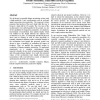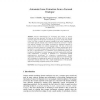10 search results - page 2 / 2 » Measuring and defining the experience of immersion in games |
CHI
2004
ACM
14 years 4 months ago
2004
ACM
The effectiveness of virtual environments (VEs) has often been linked to the sense of presence reported by users of those VEs. (Presence is defined as the subjective experience of...
AUIC
2006
IEEE
13 years 10 months ago
2006
IEEE
We developed a wearable fatigue monitoring system with a high-sensitivity 2-axis accelerometer and an on-board signal processing microcontroller. The proposed system measures fain...
CIKM
2009
Springer
13 years 5 months ago
2009
Springer
Work on evaluating and improving the relevance of web search engines typically use human relevance judgments or clickthrough data. Both these methods look at the problem of learni...
NLDB
2007
Springer
13 years 10 months ago
2007
Springer
Various methodologies for structuring the process of domain modeling have been proposed, but there are few software tools that provide automatic support for the process of construc...
JSS
2006
13 years 4 months ago
2006
This paper describes an approach to the feature location problem for distributed systems, that is, to the problem of locating which code components are important in providing a pa...


